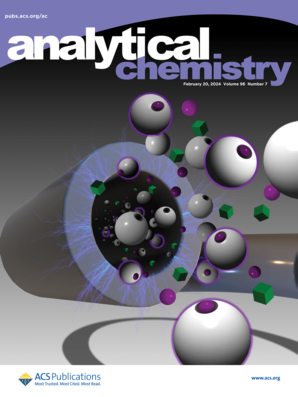Integrating Ferroelectric Fields with Active Sites for the Construction of Highly Efficient Nanozymes
IF 6.7
1区 化学
Q1 CHEMISTRY, ANALYTICAL
引用次数: 0
Abstract
Enhancing nanozymes’ catalytic activity is challenging yet crucial for practical applications. Herein, inspired by the electrostatic preorganization effect in the catalytic process of natural protein enzymes, a nanozyme is constructed by decorating ferroelectric BaTiO3 nanoparticles (BTO) with hemin, which is often regarded as the active site of natural horseradish peroxidase (HRP). The Hemin-BTO nanozyme demonstrates excellent peroxidase-like (POD-like) activity with the catalytic constant (Kcat) up to 9.71 × 105 s–1 and 1.41 × 106 s–1 for TMB and H2O2 substrates, which is ca. 240-fold and 400-fold greater than that of HRP. Theoretical studies utilizing Density Functional Theory calculations revealed the underlying mechanism. The spontaneous polarization electric field of BTO adjusts the internal electrostatic field of the active site hemin, thereby enhancing the affinity between the Hemin-BTO nanozyme and the substrate. Simultaneously, the existence of hemin reduced the recombination of BTO charge carriers, accelerated electron transfer, and thus promoted the generation of reactive oxygen species, effectively enhancing its POD-like activity. In addition, Hemin-BTO has been successfully used to establish an immunoassay of human brain natriuretic peptide. This work presented a feasible strategy to construct nanozymes with highly catalytic activity by integrating the ferroelectric fields with the active site of natural enzymes.

求助全文
约1分钟内获得全文
求助全文
来源期刊

Analytical Chemistry
化学-分析化学
CiteScore
12.10
自引率
12.20%
发文量
1949
审稿时长
1.4 months
期刊介绍:
Analytical Chemistry, a peer-reviewed research journal, focuses on disseminating new and original knowledge across all branches of analytical chemistry. Fundamental articles may explore general principles of chemical measurement science and need not directly address existing or potential analytical methodology. They can be entirely theoretical or report experimental results. Contributions may cover various phases of analytical operations, including sampling, bioanalysis, electrochemistry, mass spectrometry, microscale and nanoscale systems, environmental analysis, separations, spectroscopy, chemical reactions and selectivity, instrumentation, imaging, surface analysis, and data processing. Papers discussing known analytical methods should present a significant, original application of the method, a notable improvement, or results on an important analyte.
 求助内容:
求助内容: 应助结果提醒方式:
应助结果提醒方式:


